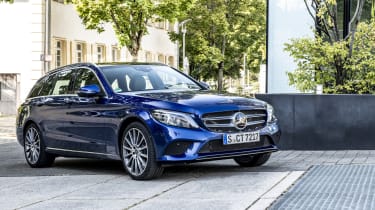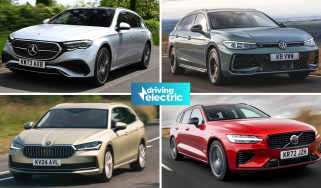Mercedes C-Class hybrid estate (2014-2021) review
The Mercedes C-Class is unique among plug-in hybrid estates in offering buyers a choice of petrol-electric or diesel-electric power

Pros
- Comfortable and refined
- Good electric range
Cons
- Weight blunts performance slightly
- BMW 3 Series more exciting to drive
| Car type | Electric range | Fuel economy | CO2 emissions |
|---|---|---|---|
| Plug-in hybrid | 33-34 miles | 166-217mpg | 33-38g/km |
There are plenty of hybrid estate cars you can choose from, with notable examples including the BMW 330e Touring and Volkswagen Passat GTE Estate. But the Mercedes C-Class is unique in being available in both petrol-electric and diesel-electric forms, in the shape of the C 300 e (petrol) and C 300 de (diesel).
Both promise ultra-low running costs, especially for company-car drivers, but the diesel is perhaps the more interesting prospect of the two, especially for those who are likely to regularly exceed the car's 30-or-so miles of electric range and would like something that's still relatively efficient once the battery power has been depleted. We've yet to drive a petrol example, but we rate the diesel highly for its useful mix of abilities.
The combination of diesel engine and electric motor in the C 300 de estate together make 302bhp, which makes for a 5.7-second 0-62mph time and a top speed of 155mph. The C 300 e petrol is fractionally more powerful, making 316bhp, and thus manages the 0-62mph sprint in 5.5 seconds. Both versions have their top speed limited to 155mph and can hit a motorway-friendly 80mph under electric power alone.
In the UK, the C 300 e and C 300 de estates are offered in Sport Edition, AMG Line Edition, AMG Line Night Edition Premium and AMG Line Night Edition Premium Plus specifications. Depending on the exact trim level chosen, CO2 emissions are between 33 and 38g/km, but in all cases, the company-car Benefit-in-Kind (BiK) rate during the 2021/22 financial year is just 11%.
And if your commute is within the C-Class hybrid estate's electric range and you can keep the battery topped up with regular charging, you may hardly use any petrol or diesel at all during routine day-to-day motoring. Driving around town in pure-electric mode is a serene, relaxing experience for the most part, although it can take a bit of practice to pull away from traffic lights smoothly given the electric motor's instant power delivery.
Progress is near-silent, with just a faint hint of motor and transmission whine to remind you of how the car is powered. Once it switches on, the C 300 de's engine is a long way off the clattery diesels of old, but it's still noticeable on start-up. It quietens down very nicely once you're at a steady cruise, while the C 300 e petrol has similar characteristics, albeit not being as noisy on start-up.
On the move, the Mercedes C-Class hybrid will assist you in getting the best possible fuel-efficiency by suggesting when to lift off the throttle, factoring in an imminent change of speed limit or downhill stretch of road. When it comes to handling, a regular non-hybrid C-Class does feel a bit sharper and quicker than the C 300 e or C 300 de, which is an unavoidable consequence of the weight added by the hybrid system.




